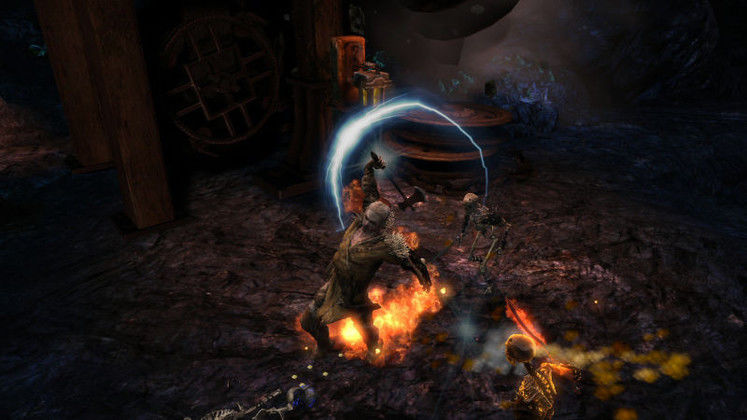Years later we’re greeted with Dungeons and Dragons: Daggerdale, a co-op enabled XBLA title that’s built around instance-style quests and simple swordplay and sorcery. The era of D&D has long past, (not by request, merely by Bioware moving onto its own projects), so seeing a title with the rule set attached is fairly exciting.
 |
| Daggerfail |
Is Daggerdale a sudden resurgence? Does it do the franchise proud? Are we looking at a mindless snooze-fest? It’s not hard to guess which one of the three it falls under.
The key to approaching Daggerdale is its delivery method. This is a downloadable game after all – it’s not a sprawling epic fantasy adventure harking back to the good old days of the series. Rather it’s a dungeon crawler with D&D’s rules and lore hiding underneath. If we’re honest it could have been called Daggerdale and you wouldn’t be any the wiser. There’s passing references to characters and events that die-hard fans will notice, but for the rest of us this is simply an adventure RPG that takes place underground.
As with every game in the genre you pick a character. In Daggerdale there’s four to choose from; the Elf Rogue (our choice), Human Warrior, Dwarf Cleric and a Mage. Assign some skill points, choose some traits, tweak your name and you’re good to go. It’s pretty bog standard stuff.
Once you’re in game and past the opening animated cut scenes (with voice acting - the only time it happens in the game), you’re unleashed on the Mines of Moria to cut your way through Goblins. Wait, wait, sorry, the underbelly of generic-fantasy-world-101, not Lord of the Rings.
It’s typical fantasy stuff – dwarfs and eventually other allies hand out quests across a decently sized campaign. Your overarching storyline brings you up against the usual arch-evil-villain, while side quests have you collecting trinkets, assisting lost people and smashing barrels to smithereens.
Unleashing your rage on barrels is an essential part of Daggerdale. Aside from the odd chest while holds shiny loot, your money and potions come from the barrels populating the world (at least they’re not explosive...). It’s so obvious a design choice that the developers decided to insert a joke, (a term used loosely), character in the game whose sole purpose is to scorn you for your prejudice against wooden containers.
 |
| Dungeons and Drudgery |
Moving away from mindless destruction and back to the core gameplay, you’re ushered around the dull caves with forgettable characters. As they murmur (it’s presumably all that the voice budget could afford) their instructions at you, you can’t help notice the linearity, hand holding and closed-in feeling of Daggerdale. It is essentially one big dungeon crawl with its chapters broken up with easy bosses and some quick plot progression thrown in for good measure.
It’s bite-sized Dungeon Siege without the polish.
Environments? Dark, dank corridors and pretty much nothing else. Inhabiting the nooks and crannies are Goblins, the odd corrupt human, some Lizardmen and the Undead. They’re scripted in their appearance and have the annoying habit of respawning every time you finish a quest subsequently removing the need for expansive settings and bringing about a fair bit of backtracking.
Even more irritating is the fact they’re broken. For example, one of the Rogue’s traits is the ability to roll out of the way of incoming projectiles. When you do this the enemies seem to break, stop their attacks and watch as you cut into them. It isn’t until you kill an insta-clone that they get wise to what’s going on and start to fight back again. This happens far too often and makes the game easy in a way that was obviously not intended.
The combat itself is a simple button mashing affair. You’ve got one for ranged and one for melee. Special attacks can be assigned to accordingly and potions help return you to good stead. The result is a trudge through the armies of monotony. It’s oddly addictive, in a mindless unchallenging way (increasingly effective loot keeps you hooked), but for those looking for a deep combat system, you’re best searching elsewhere.
Even when you jump online (if you can get it to work), with up to four others, it’s still repetitive and archaic. Don’t get us wrong – combat doesn’t need to be so complex that you need a manual to understand it, but when it’s reached the point of ‘move-attack-heal’ then something needs to be addressed. This repetition isn’t helped by the respawning mentioned above and the fact that if you fail a mission (even if it’s right at the end against a boss), you’ll have to do it all over again.
There’s no in-quest checkpointing and it can be extremely frustrating, especially when it wipes the gear you’ve picked up and the experience you’ve gained.
 |
| Role Playing Shame |
Visuals don’t help the feeling of tedium – it’s not particularly exciting or colourful and while we understand it’s a downloadable title, it’s pretty muddy with its textures and character design. You get the choice of two perspectives – a pseudo isometric approach or a closer behind the shoulder style viewpoint. Neither helps jazz things up at all.
By the time you reach the end boss, complete with compulsory quick-time events, you’ll be glad it’s over. Daggerdale doesn’t do anything out of the ordinary – it’s a typical plod through the world of D&D, and a stale one at that. There are better RPGs out there and while it’s best enjoyed with friends, if you can find a group that owns a copy, you’ll more lucky than a Euromillions winner.
DUNGEONS & DRAGONS: DAGGERDALE VERDICT
Avoid unless you have simple expectations.
TOP GAME MOMENT
As with all dungeon crawlers, loooooot.




